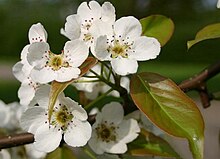|
Pyrus ussuriensis
Pyrus ussuriensis, also known as the Ussurian pear, Harbin pear, and Manchurian pear, is a species of flowering plant in the family Rosaceae.[1] It is native to Korea, Japan, china, and the Ussuri River area of far eastern Russia. It has flowers in spring that are slightly pink when budding and then turn white.[2] Buds are dark brown and have an alternating arrangement. The tree grows to a height of about 15 meters (49 ft) and prefers well-drained loam-type soils. It is considered the hardiest of all pears.[3] When planted in milder climates, the trees have been known to be killed by freezes after they begin budding.[3] Many species of birds and mammals feed upon the fruit of this species. Deer, mice, and rabbits are known to damage the trees.[4] Leaves are dark green in spring and summer and turn dark red and gold in autumn.[2] Products made from the fruits may prove more effective than commercial insecticides in killing ticks and mites.[5] The fruits are not the tastiest of pears to humans, but the taste is better after a freeze and the juice tastes better. Crosses of this species with other pears produces tasty pears that grow in climates too cold for most pears.[3] Cultivars include the 'Reli', 'Jinxiang', 'Hongbalixiang', 'Baibalixiang', 'Fuwuxiang', 'Qiuxiang', 'Fuanjianba', 'Longxiang', 'Guanhongxiao', 'Shanli24', 'Wuxiangli', 'Shatangli', 'Manyuanxiang', 'McDermand' , and the Prairie Gem® Flowering Pear (cultivar ‘MorDak’).[4] There are at least 108 compounds in the fruits that affect plant breeding and these show that P. ussuriensis cultivars fall into 4 groups.[6] References
External links
|
||||||||||||||||||||||||||||||
Portal di Ensiklopedia Dunia

